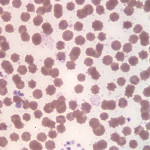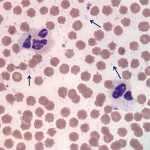Peripheral blood from a cow
Case information
A 4 year-old Holstein cow was examined due to an acute drop in milk production. The cow freshened two weeks prior to presentation and had initially been producing good quantities of milk. In addition to the acute drop in milk production, the teats in all four quarters were swollen and painful. The swelling decreased with ceftiofur and furosemide therapy, but clinical signs did not fully resolve. Upon examination by a veterinarian, the cow was found to be mildly depressed, slightly underweight with uniformly swollen teats, mild swelling of the distal portion of the hind limbs and a fever of 104.1°F. An EDTA blood sample was taken for blood smear evaluation and milk was sampled for culture. These were then sent by mail to the Animal Health Diagnostic Center at Cornell University and took a day to get to us. The veterinarian did submit smears of the blood (made from freshly collected blood) along with the EDTA tube. We made smears in the laboratory from the stored (aged) blood.
Have a look at the provided images (made from the stored EDTA tube) and see if you can then answer the following questions:
- Is sample preservation ideal for blood smear evaluation?
- What morphological abnormality do the red blood cells demonstrate?
- What are the light purple-pink, extracellular, granular structures indicated by the arrows in Figure 2 (also present in Figure 1)? What is their significance to this case?
Answer on next page


